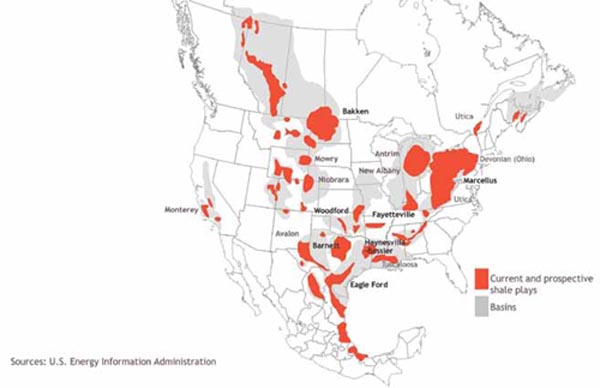THE
SHALE REVOLUTION
OKLAHOMA CITY, OK – If the states serve as incubators and laboratories for innovation, one needs to look no farther than Oklahoma for a comprehensive national energy plan.
World-Gen was invited to attend the 2011 Governor’s Energy Conference held in the Cox Convention Center where Governor Mary Fallin unveiled the Oklahoma First Energy Plan.
“Today the nation is undergoing an energy revolution,” Fallin told the 400 delegates. “Unprecedented new supplies of natural gas, a renaissance in oil production, and a newfound ability to economically capture energy from the wind are redefining the energy landscape.”
Her agenda is built around the belief that we must continue to improve, not replace, traditional energy sources like oil and natural gas, and that effective energy policy does not rely on federal subsidies or mandates, but instead allows the private sector to grow and flourish.
|

Governor Mary Fallin
|
| She continues to aggressively support the
construction of the Keystone XL Pipeline
that will link Oklahoma to new markets.
The pipeline represents an investment that
could result in $1.2 billion in increased
business activity in Oklahoma and an
increase in personal income of $874 million.
Her support of safe hydraulic fracturing
is unwavering. Fracking is an essential
process to the future of Oklahoma’s energy
industry. “Oklahoma companies have
been doing it safely for over 60 years. So
to show the rest of the nation that fracking
is a safe and essential process, I’m asking
our policy makers and the energy industry
to support public disclosure of chemicals
on the Oklahoma-originated website,
FracFocus.org,” she pledged.
The Oklahoma City-based Ground
Water Protection Council (GWPC), working
in conjunction with the Oklahoma Citybased
Interstate Oil and Gas Compact
Commission developed the nationally
acclaimed FracFocus (www.
fracfocus.org) voluntary
disclosure database for
chemicals used in hydraulic
fracturing.
Wind
Oklahoma’s wind
resources are ranked 8th in
the US for wind production.
Wind energy provides 3,000
jobs throughout the state
and contributes to more
than $13 million a year in
property tax and land lease
payments. In the Panhandle alone, the
state could develop more than 8,400mw’s
of wind generation capacity, leading to as
much as $38 million in land payments and
$1.2 billion in wind electricity generation.
The Oklahoma Corporation
Commission recently approved utility status
to Plains and Eastern Clean Line to
build 800 miles of HVDC transmission.
Between 2020 and 2025, the Southwest
Power Pool expects its nine-state region to
produce 8,500 mw’s of wind power, with
more than half coming from Oklahoma.
The US Department of Energy predicts
that by 2030, Oklahoma could be the second-
largest generator of wind power in the
nation. According to the Oklahoma Wind
Power Initiative (OWPI). Oklahoma has
about 2.3 times more wind energy potential
per square mile than Texas.
Michael Revak, vice president of
Siemens Wind Power Americas’, spoke of
Siemens commitment to Oklahoma.
Siemens provided 44 SWT-2.3-93 wind turbines
to Oklahoma Gas & Electric and the
University of Oklahoma for the OU Spirit
Wind Farm located near Woodward.
Additionally, Siemens supplied 442.3-93
units for the Keenan I farm and 66 SWT-
2.3-101 units to CPV Renewable Energy
Company’s 151.8mw Keenan II Wind
Farm. Siemens is also providing 95 SWT-
2.3-101 wind turbines and three units of
the SWT-3.0-101 direct drive wind turbines
for OG&E’s Crossroads Wind Farm located
in Dewey County.
Siemens announced plans for a new
wind service warehousing operations in
Woodward. Construction of the two facilities
is expected to be completed by the
end of 2011. With a total of 64,000 sq. ft.,
the combined main component, tooling
and spare parts facilities will be Siemens’
largest wind power service distribution
center in the US, creating up to 40 “greencollar”
jobs |
GEOTHERMAL
“Our capitol building is the only geothermal
state capitol in the country and is
in that sense a model of efficiency,” she
went on to say. Oklahoma is also the
nation’s leading geothermal heat pump
state. The geothermal industry in
Oklahoma employs more than 4,200 with
annual revenues in excess of $550 million
per year.
COAL
97% of the coal consumed in
Oklahoma is used for power generation and is imported from Wyoming. The
cement and lime industries serve as the
primary consumers of Oklahoma coal with
increasing volumes of metallurgic-grade
coal. The Oklahoma coal industry accounts
for an estimated $146 million in economic
activity, generates $42 million in Oklahoma
income, and supports 1,153 full-time equivalent
jobs.
ENERGY EFFICIENCY
“Oklahoma continues to be ranked as
one of the least energy-efficient states in
the nation. That’s why I’m asking the legislature
to work with me to pass a law
requiring every state agency to establish
an efficiency improvement target of to 2%
per year through 2020,” Fallin noted. |
 |
|
NGV’S
Fallin announced a new initiative
launched jointly with Governor John
Hickenlooper of Colorado designed to
increase the use of natural gas vehicles
(NGV’s) in state automobile fleets. Other
states, including Wyoming and
Pennsylvania have also signed onto the
agreement.
The MOU lays the groundwork for
the formation of a Multi-State Request for
Proposal, where the states would prepare a
formal request to automobile manufacturers
to design an NGV and sell it in bulk to
participating states.
HB 1909
The Governor’s plan was shepherded
by C. Michael Ming, Oklahoma’s Secretary
of Energy who was appointed to his first
government position by Governor Fallin in
January, 2011. Over 200 stakeholders participated
in the year-long energy working
group.
The centerpiece of the First Energy
Plan was H.B. 1909, the Shale Reservoir
Development Act of 2011 that repealed the
100 year old Oklahoma vertical well case
law to adopt advancements in horizontal
drilling. John Richels, CEO and president
of Devon Energy, called it “The Shale
Revolution” in his morning address.
There’s been a “geological paradigm shift”
and we are no longer chasing structural
and stratigraphic traps. Shale gas now represents
greater than 25% of domestic supply,
with estimates of 100 years of supply.
US gas reserves have increased by 55%.
Oklahoma produced more than 1.8
trillion cubic feet which accounted for
more than 80% of the state’s overall energy
production. Oklahomans consumed only
one-third, leaving about two-thirds for
export. Oklahoma currently boasts nearly
23 Tcf in reserves. Its energy supplies vary
slightly from the US average primarily due
to the absence of nuclear generation. In
2009, the state produced almost 2.6 quads
of energy, ranking the state eighth in
terms of total energy production.
R & D OPPORTUNITIES
Both private and public investments
in R&D programs play a key role in positioning
Oklahoma at the forefront of the
emerging energy industry. The US
Energy Independence and Security Act
requires the production of 35 billion gallons
of ethanol by 2022.
Nearly half will come from cellulosic
feedstocks. Oklahoma
can play a key role. If
Oklahoma were to dedicate
35% of the farm land in the
state to biofuels feedstocks, it
could supply the US with as
much as 49.5 million tons of
switchgrass used to generate
these biofuels. The EPA estimates
that, by 2022, 85% of the
biofuels produced from switchgrass
in the US will come from
biorefineries located in
Oklahoma.
At the Oklahoma
Bioenergy Center, a consortium
between the University of
Oklahoma, Oklahoma State
University, and the Noble
Foundation, researchers specializing
in energy and agricultural
development are working
to advance the next generation
of renewable alternatives for
petroleum-based transportation
fuels. Conservative estimates suggest
that the state’s $15.4 million investment
into the center has already resulted in an
economic development impact of nearly
$97 million.
In 2011, through a project made possible
by the Oklahoma Bioenergy Center,
researchers at the Samuel Roberts Noble
Foundation uncovered a gene responsible
for controlling the growth density of plant
material. The discovery, termed “biomass
densification,” has been heralded as a key
advancement in biomass feedstock
research. |


